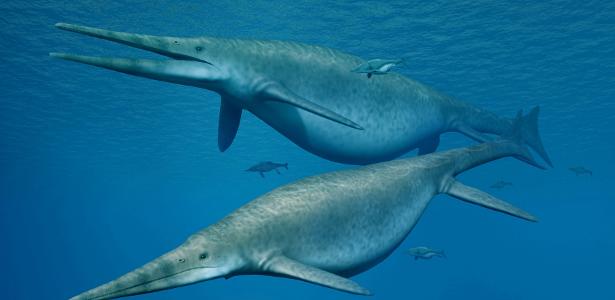Scientists at the University of Bonn in Germany have discovered a 205-million-year-old ichthyosaur in the Alps of Switzerland. According to the researchers, the animal was larger than the blue whale and lived in the Pantalasian Ocean around Pangea during the late Triassic period.
The ichthyosaur, which has characteristics of both reptiles and fish, was originally identified when fossils were found between 1976 and 1990 in rocks over 2,700 meters high. Despite the intriguing elevation, the site was once home to a large lake bed, as revealed by a new study published today in Journal of Vertebrate Paleontology.
This type of animal became extinct 90 million years ago, even before the asteroid collision that wiped out the dinosaurs, according to the British newspaper, the Daily Star.
Dr Martin Sandler of the University of Bonn said there may be more remains of “giant” marine creatures hiding under the glaciers.
The find surpassed two other fossil finds: an ichthyosaur from Canada called Shonisaurus sikanniensis, which was 21 meters long, and a 25-meter Jurassic “sea dragon” that roamed the British coast at about the same time.
The size of the animal is a selective advantage, Sandler said, and that only three groups of animals weigh 10 to 20 tons, and among them are the ichthyosaurs. “There were only three groups of animals weighing more than 10-20 metric tons: the long-necked dinosaurs, whales, and the giant Triassic ichthyosaurs.
The root of the animal’s tooth alone is twice as wide as the previous record of another ichthyosaur, which was 15 meters from nose to tail.
Because of the animal’s size, Martin said more should be known about them. “It is a great embarrassment to paleontology that we know so little about these giant ichthyosaurs, despite the extraordinary size of their fossils.”
In addition to stature, ichthyosaurs made an important evolutionary leap in reproduction: instead of laying eggs, they began giving birth to live young. And because it looked like a fish, it could reach a speed of 35.4 km / h.
doctor. Heinz Furer, retired curator of the Paleontological Museum of the University of Zurich, celebrated this discovery. “It is the tallest ichthyosaur in the world, with the largest tooth ever found and the largest torso vertebra in Europe.”
In January this year, another fossil of Ichthyosaurs were found in the Midlands, UK. It was about 180 million years old, 10 meters long, and had a skull that weighed a ton.

“Music fanatic. Professional problem solver. Reader. Award-winning tv ninja.”







More Stories
Venezuela's embassy and consulates in Ecuador were closed after Maduro's order
United begins swapping Boeing 737 MAX 10 planes for Airbus A321neo planes
Nicolas Maduro's English has become an internet joke